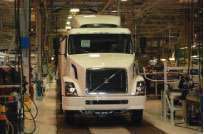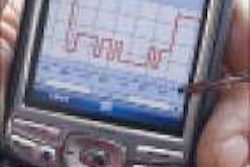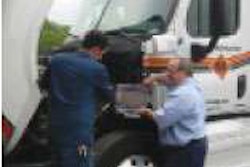Volvo eyes the future
With EPA 2010 in rearview mirror, fuel economy looms
During a conversation with industry journalists last month, Denny Slagle, president and chief executive officer of Volvo Trucks North America, touched on a number of industry topics, including meeting with President Obama and U.S. Transportation Secretary Ray LaHood on boosting fuel economy standards for heavy-duty trucks, the success of Volvo’s 2010 engine family and even Volvo’s future in the North American marketplace.
 Volvo Trucks North America says it is “way ahead of the curve” with its current engine technology platform, and customer acceptance has been “exceptionally good.”
Volvo Trucks North America says it is “way ahead of the curve” with its current engine technology platform, and customer acceptance has been “exceptionally good.”Commenting on his meeting with Obama and LaHood, Slagle noted that a dialogue had been established, although he admitted it would be nice to have a “breather” to recoup some research and development costs spent on meeting the U.S. Environmental Protection Agency’s stringent 2010 emissions standards for diesel engines.
“Volvo has walked a fine line for an entire decade meeting the 2010 EPA regulations,” Slagle noted. “But we believe in protecting the environment. So it was a logical course for us.” The company now finds itself in the same boat with all truck OEMs, he said. “Times now demand that OEMs focus on CO2 emissions and fuel economy. And Volvo wants to be part of that process and help craft these standards as opposed to waking up one morning and having a tablet handed down to us from the mountaintop,” he said.
The Obama administration is looking at implementing CO2 and fuel economy standards beginning in 2014 and ending in 2017, which Slagle said will give the truck industry a working window. Volvo is working hard to improve fuel efficiency, but must be sensitive to commercial standards and keep extra costs that its customers can’t bear out of the equation.
Looking at Volvo’s current market share, Slagle said he’s pleased with the industry’s reception to selective catalytic reduction technology. “SCR lets an engine be an engine again,” he said. “Frankly, I wish we’d put SCR on our engines in 2006.” SCR is changing the way customers buy trucks, Slagle said, noting that in the past, people bought an engine and built a truck around it. “Now, they’re buying trucks and getting better integrated products as a result.” Slagle added that he “wasn’t proud” of how Volvo handled the launch of its 2007 engine family, but noted that the company’s 2010 engines have logged more test miles than any other OEM. As a result, Slagle is confident Volvo is “way ahead of the curve” with its current engine technology platform and added that customer acceptance of Volvo’s 2010 engines has been “exceptionally good.”
Slagle believes the economy is rebounding and will continue to do so, noting that the overall economic picture is healthier than the media tends to present it. Another positive point for Volvo is that the company’s dealer network weathered the financial crisis and came through in “very strong” shape. Coupled with the fact that Volvo managed its own corporate finances with a steady hand means the company is in prime condition to better penetrate all segments of the trucking industry.
On the negative side of the economy, Slagle said the industry as a whole is just entering into a vehicle replacement cycle as opposed to an expansion cycle. And despite some early signs of life in the construction and vocational markets, those industries have not sprung back to healthy performance levels yet. And as the economy continues to recover, Slagle sees a good chance that raw material shortages may hit North America again, driving prices up and delaying production times.
When asked point-blank about rumors that Volvo would leave the North American truck market, Slagle was typically blunt. “Volvo is a global company, and if you’re a global player, you don’t pull out of the biggest truck market in the world.” Slagle said that in terms of dollars, Volvo is No. 1 in global diesel engine production. “We have both the resources and the staying power to compete in North America, and we will continue to do so. Just watch us.”
– Jack Roberts
IN BRIEF
* Navistar will remain the exclusive provider of Class 8 tractors for truckload carrier Heartland Express. The agreement calls for delivery of International ProStar+ tractors with U.S. Environmental Protection Agency 2010-compliant MaxxForce 13 engines.
* Meritor WABCO Vehicle Control Systems is continuing its series of ride-and-drive vehicle demonstrations across the country, displaying its series of progressive active Safety Systems technologies. To register, go to www.meritorwabco.com.
* Yokohama Tire Corp’s manufacturing plant in Salem, Va., signed a four-year contract with the United Steelworkers Local 1023. Contract highlights include a no-closure guarantee for the plant during the life of the agreement.
* Hino Trucks entered into an agreement with Hitachi Capital America Corp. that expands Hino’s commercial financing options. In addition to Hino’s captive financial partner, Toyota Financial Services, Hino’s dealers and customers now have access to Hitachi’s retail and wholesale financing offerings.
* Dometic announced the availability of remanufactured auxiliary HVAC units for truck sleepers. The systems operate on 115-volt AC power and work with most types of auxiliary power units as well as shorepower hookups.
* Thermo King is offering customers rebates of up to $250 when they purchase qualifying parts for Thermo King and Carrier units from participating Thermo King dealerships in the United States and Canada. The program runs through Sept. 30.
Marmon showcases commercial vehicle portfolio
It has been more than a dozen years since the last heavy-duty truck bearing the Marmon name rolled out of a factory, but the company that still shares that name is bigger and more integrated into the trucking industry than ever.
Marmon Highway Technologies last year hit the road to show its major customers the depth and breadth of the commercial vehicle products offered by 13 independently operated companies serving customers in the automotive aftermarket, commercial truck, heavy-duty trailer and undercarriage markets worldwide – from quarter fenders to entire platform trailers and much in between. In late May, MHT took that same message to the trucking media at a private trade show in Birmingham, Ala., dubbed “Ideas in Motion.”
MHT’s individual companies date back to the 1940s, but it has been only since 2002 that The Marmon Group pulled those companies together under the MHT umbrella. Another major milestone came in 2008 when The Marmon Group was acquired by Berkshire Hathaway.
With a culture of innovation and the financial resources that come with ownership by Berkshire Hathaway, MHT has continued to invest in research and development, said MHT President Kelly Dier. MHT companies have invested more than $25 million in R&D since 2003 to develop new products and solutions for OEM, fleet and aftermarket customers. The company has spent more than $130 million over the same period on equipment and facilities to design, test and manufacture new products.
“Our continually expanding investment in R&D and infrastructure has resulted in an unprecedented number of new products being introduced in 2009 and 2010,” Dier said. “While other companies pulled back to try to wait out the latest cyclical downturn in the trucking industry, we’ve used our financial strength and stability to invest in the future for our customers.”
In a prediction that certainly would hearten many of MHT’s trucking company customers, Dier predicted that the outsourcing of manufacturing to China and other countries due to labor costs will reverse over the next 20 years because of rising logistics costs – especially fuel – and the need for tighter supply chains. Dier – a 40-year veteran of the commercial vehicle manufacturing industry – predicted that diesel fuel prices would soar to $6 to $7 a gallon within five years, forcing North American companies to source materials much closer to their plants.
“We’re going to reach a point where the way we have been running our business logistics will no longer make sense,” Dier said. “Today, it is common to source worldwide for cheap labor. But logistics costs are going to get so high that companies will have to develop much tighter supply chains.” In addition to saving fuel, tighter supply chains allow companies to respond more quickly to an uptick in orders, he said.
But don’t expect these changes to happen tomorrow, Dier cautioned. “It’s going to be a hard transition,” he said. North American machine shops, foundries and fabricators are gone and will have to be recreated. “It’s going to be a 20-year process, but the result will be good for the businesses and citizens of the United States, Canada and Mexico.”
Some of the featured products, technology and services in the “Ideas in Motion” include:
• The Fontaine Ultra line of fifth wheels, including the Fontaine Ultra NS with infinite automatic slack adjustment, the lightweight Fontaine Ultra LT and the lighter-weight heavy-duty Fontaine Ultra HD (Fontaine Fifth Wheel);
• Certified installation of alternative fuel engines, alternative fuel delivery systems and auxiliary power units (Fontaine Modification Co.);
• The Flex Wedge lightweight mudflap retaining system, fiberglass fenders, Hogebuilt wide-base tire fenders, heavy-duty construction fenders and Body Armor fender coating (Fontaine Spray Suppression);
• The modular Fontaine Magnitude 55MX heavy-haul trailer and lightweight Fontaine Revolution Hybrid Dropdeck trailer (Fontaine Trailer Co.);
• A Tire Pressure Adjustment System (TPAS) that allows rapid deflation and individual tire pressure settings (Marmon-Herrington);
• A lightweight leaf spring replacement for Mack camelback suspensions (Triangle Suspension Systems);
• The TSE Omnibrake High Output Technology (HOT) for disc brake and S-cam drum brake applications, an alternative to piston-type disc brakes that provides higher parking or emergency force while maintaining low hold-off pressure (TSE Brakes); and
• Lightweight aluminum trailer disc wheel hubs, the lightweight lower-heat Webb Vortex brake drum, W43 asbestos-free friction for the transit market and Super Kits, a brake drum, friction and hardware package for the transit and coach markets and other severe-duty applications (Webb Wheel Products).
In a tour for journalists in late May, MHT demonstrated some of its R&D investments at the Fontaine Fifth Wheel facility in Trussville, Ala., and at the facility in Cullman, Ala., where TSE Brakes has moved its headquarters and R&D facilities to join Webb Wheel’s headquarters and R&D lab.
MHT companies are grouped into four independent subsectors: Commercial Truck, Commercial Vehicle Undercarriage, Trailers and Automotive Aftermarket. MHT companies employ 2,000 employees and, in a normal market, generate more than $700 million in revenue.













